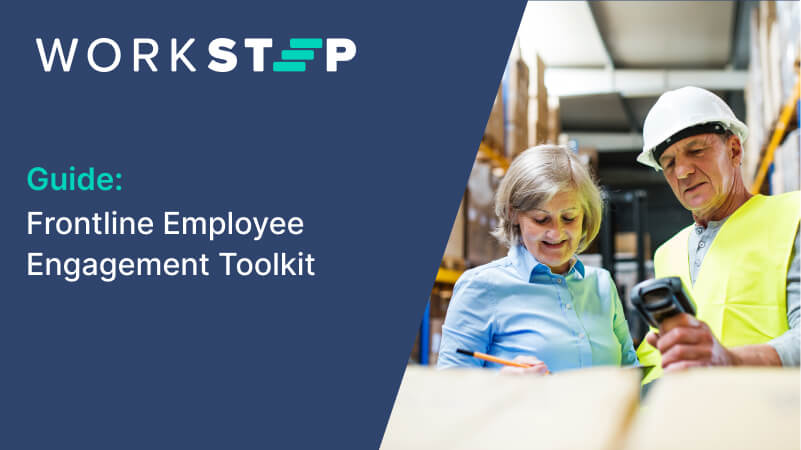Why traditional annual surveys fail to address frontline employee engagement needs
March 28, 2024
The supply chain industry is facing a significant challenge in retaining frontline workers, many of whom face burnout, lack of career growth, safety concerns, and more. Traditional employee surveys, which are typically built for a corporate workforce, conducted annually and lack actionable insights, are not effective in addressing this issue.
To more directly address frontline turnover and retention, companies need to adopt modern employee retention software that enables regular and meaningful engagement with frontline employees. This blog will discuss the limitations of traditional surveys for frontline-focused organizations and the advantages of modern employee retention software in improving frontline employee engagement, retention, and ultimately, meeting revenue goals.
Insights only once a year (by then it’s too late to take action)
Traditional annual engagement surveys are ineffective at improving frontline employee retention and meeting revenue goals because they only provide insights once a year, which is often too late to take action. By the time the feedback is received, the employee may have already moved on to a new role or department, or the company may have undergone significant changes. This can lead to employees feeling frustrated and disengaged, which can ultimately damage an organization’s company morale and decrease productivity.
To be effective, frontline employee surveys need to provide real-time, actionable insights that can be used to make immediate changes. This means deploying a continuous listening strategy focused on collecting and analyzing employee feedback on a regular basis, and taking targeted action on the feedback that is received.
Lack of local insight and impact
Annual surveys often overlook the local insight crucial for frontline-focused organizations. While they gather high level enterprise-wide feedback at a specific moment in time, they often fail to ask the right questions at the micro-level and neglect smaller actions. For frontline-focused sectors like retail or customer service, understanding specific needs is vital. Day-to-day challenges for workers can get lost in surveys designed to collect high level information from a broad population. For many workers, it’s concerns around availability of tools, communication at shift change or the coffee in the break room driving poor sentiment or low morale. Without granularity, organizations miss opportunities to make targeted improvements. Global feedback must be complemented with local insight in order to drive effective change in frontline-focused organizations.
Local action at scale has a major impact on the entire organization because it creates a positive work culture and boosts employee morale. When employees feel heard and valued, they are more likely to go above and beyond in their work and feel a sense of loyalty towards the company.
Heavily prioritizes quantitative data over qualitative insights
Some annual engagement surveys put a heavy emphasis on quantitative data. Running an employee survey or continuous listening strategy without qualitative feedback is similar to embarking on a journey without a destination in mind. While the effort of mobilizing and distributing the survey may be similar, the insights gained from quantitative data alone are often limited and lack the depth necessary to drive meaningful improvements. Year-over-year comparisons and industry benchmarks may provide a surface-level understanding of trends, but they fail to reveal the underlying reasons behind employee responses.
Survey results may indicate areas of dissatisfaction or low engagement, but without understanding the “why” behind these responses, it becomes challenging to address specific concerns and implement targeted solutions. Qualitative insights, on the other hand, provide the context and color necessary to truly comprehend employee perspectives and experiences.
Ultimately, conducting an employee survey without qualitative feedback may give the illusion of doing the right thing, but it falls short of delivering real value. Without qualitative feedback, organizations are left guessing at the reasons behind employee responses, leading to a disconnect between survey findings and actionable improvements.
Lean too heavily on exit interviews, which offer little value on their own
Similarly, at surface level, exit surveys may seem like a good idea, but there are several issues with stand-alone exit surveys.
One issue is the low response rate to exit surveys. When employees leave a company, they may be reluctant to take the time to fill out a survey, especially if they are feeling negative about their experience. This means that the results of exit surveys may not be representative of the overall employee population.
Another reason why exit surveys are ineffective is that employees may be hesitant to provide honest feedback. They may be concerned about burning bridges with their former employer, or they may simply not want to be negative. This can lead to exit surveys providing a rosy picture of the company, even when there are serious problems.
Finally, exit surveys provide a narrow and incomplete view of employee sentiment. They only capture the opinions of employees who have already left the company. This means that they do not provide any insight into the experiences of current employees, who may be just as likely to leave if their concerns are not addressed.
While employee exit surveys are a valuable tool for gathering feedback from departing employees, they should not be the only input for decisions about organizational needs and goals.
Don’t scale with consultant-led solutions
Consultant-led employee surveys face significant challenges when scaling beyond organizations with 1,000 employees. Consultants often lack the ability to empathize with the day-to-day experiences of frontline employees, as they are not directly involved in the business. This can lead to a disconnect between the feedback collected and the actual needs and concerns of the workforce. Furthermore, consultants may not have the necessary industry-specific knowledge to provide tailored advice that addresses the unique challenges of the organization.
The cost of hiring consultants for employee surveys can also be prohibitive, especially for larger organizations. Consultants typically charge high fees for their services, and these costs can quickly add up when conducting surveys across a large employee base. Additionally, there is a risk of biased or self-serving advice from consultants who may have vested interests or personal agendas that influence their recommendations.
Tune into your frontline with WorkStep
With the frontline employee engagement platform that delivers the real-time insights you need to take action, retain your workforce, and drive your business forward.
Fail to enable and empower action
Traditional annual frontline employee engagement surveys typically excel at collecting and analyzing feedback from employees, providing valuable insights into the organization’s culture and employee satisfaction levels. However, they often fall short in translating this analysis into concrete actions that drive business outcomes and improve overall performance. While the surveys identify areas for improvement, they frequently lack a robust mechanism for linking feedback to strategic initiatives and measurable outcomes like employee turnover and retention. Without predictive analytics tied to business outcomes, organizations risk squandering the potential benefits of employee feedback, as they fail to implement meaningful changes that positively impact the bottom line and overall success of the business.
Conclusion: Embracing continuous listening
Embracing continuous listening through modern frontline employee engagement solutions helps frontline organizations achieve sustainable business growth. Unlike traditional annual surveys, continuous listening fosters ongoing communication and feedback loops, ensuring that frontline workers’ voices are heard and valued consistently. This approach enables organizations to not only collect feedback but also tie it to business outcomes and quickly implement actionable strategies for improvement.
By prioritizing consistent employee feedback and taking prompt action based on their insights, organizations can cultivate a more inclusive and engaged workplace culture. This, in turn, leads to heightened employee satisfaction and retention rates, driving increased productivity and organizational success.
Kayla Pimentel, | kayla@workstep.com
Kayla Pimentel serves as a Demand Generation Associate at WorkStep. Leveraging her diverse background in sales and marketing, she is enthusiastic about sharing insights about how to make the frontline a better place to work.



